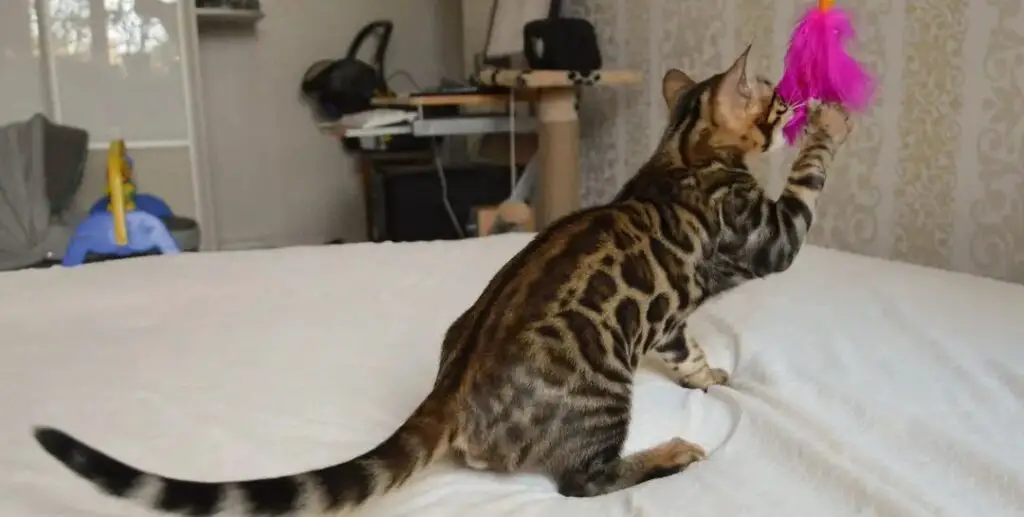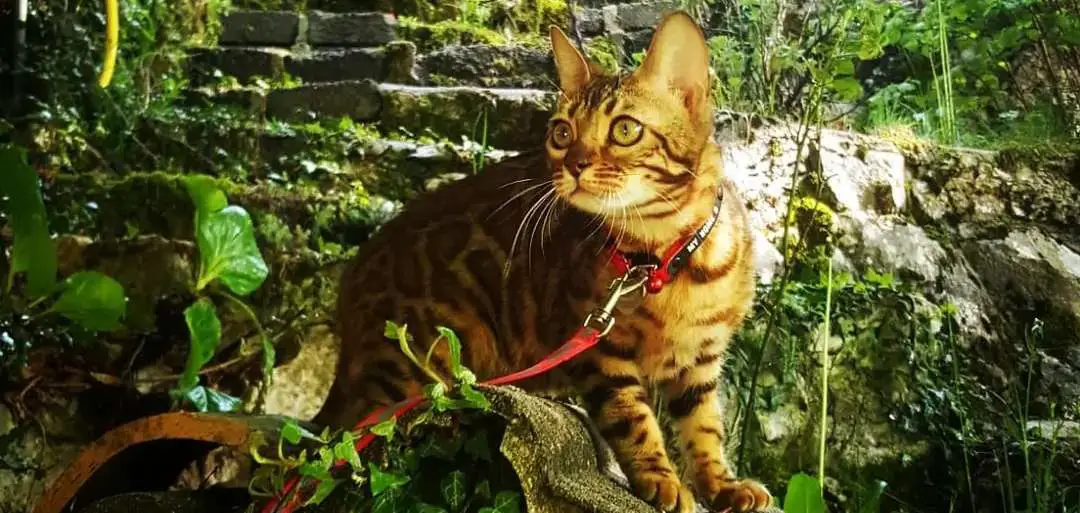Is it safe to let a Bengal cat outside? Let’s find out together…
As a long-time cat owner, I can tell you that there are a lot of things involved in letting your Bengal cat go outside unsupervised.
In this short post, I will discuss some of the most common benefits of letting your Bengal cat out and the disadvantages, as well as things you should know before letting your Bengal cat out.
Let’s get started…
Is it Safe to Let a Bengal Cat Outside
In my opinion, it is generally unsafe to let a Bengal cat outside without your supervision, as Bengal cats are known for their high energy levels and curiosity, which can put them at risk of traffic accidents, catnappers, infectious diseases, and encounters with other animals.
It is recommended to keep Bengals as indoor cats or provide them with a safe and enclosed outdoor space, such as a cat enclosure or catio, to satisfy their need for exploration.
While Bengals can benefit from outdoor activities, it is recommended to provide a supervised outdoor space to mitigate dangers like road traffic accidents and territorial fights.
Neutering/spaying can reduce the risks associated with outdoor roaming, ensuring a safer environment for Bengal cats.
Let’s look at some common benefits of letting your Bengal cat out and some disadvantages!
Benefits of letting your Bengal cat go outside

In my opinion as a cat owner, here are some common benefits of letting your Bengal cat go outside:
1. Socialization opportunities for your Bengal cat: Your Bengal cat learns important social skills from the sights, sounds, and scents it encounters when it goes outside.
The way they interact with their surroundings and other animals will greatly improve their socializing with other pets, humans, and environments.
Through exposure to a variety of settings and creatures, your Bengal cat will become more self-assured and capable of navigating unusual circumstances.
2. Reduced stress and anxiety for your Bengal cat: Your Bengal cat may find great relief from stress by going outside. Stress and anxiety can be lessened by the sunshine, open space, and fresh air.
Bengal cats, which have a reputation for having tremendous energy and the ability to act destructively when not given adequate mental and physical activity, should pay particular attention to this.
You can encourage relaxation and contentment in your Bengal cat by allowing them to explore the outdoors.
3. Providing mental stimulation for your cat: Bengal cats are naturally curious and love to explore, going outside is an added advantage to them.
When Bengal cats are allowed to go outside, they can engage in activities that challenge their minds and keep them mentally stimulated.
This could include hunting small prey, climbing trees, or even interacting with other animals.
By providing your Bengal cat with these mental challenges, you can help prevent boredom and keep them engaged and active.
4. Express their natural behaviors: Bengal cats are known for their wild ancestry, and they often exhibit behaviors that are reminiscent of their feral roots.
When they’re allowed to go outside, they can express these natural behaviors in a safe and controlled environment.
This could include hunting, climbing, or even marking their territory.
By giving your Bengal cat the freedom to express themselves naturally, you can help them feel more fulfilled and content.
5. Providing your Bengal cats with more opportunities for physical exercise: Bengal cats are known for their high energy levels and love for physical activity.
When they’re allowed to go outside, they can engage in activities that provide them with the exercise they need to stay healthy and happy.
This could include running, jumping, and even climbing trees. By giving your Bengal cat the opportunity to exercise outside, you can help them burn off excess energy and maintain a healthy weight.
6. Access to the outdoors can help alleviate boredom for Bengal cats: Bengal cats are naturally curious and love to explore. When they’re confined to a small indoor space, they can become bored and restless.
By giving them access to the outdoors, you can provide them with a new environment to discover and explore. This can help alleviate boredom and keep them engaged and active.
7. Your Bengal cat can benefit from exposure to natural sunlight: Bengal cats, like many other animals, need exposure to natural sunlight to maintain their overall health.
When they’re allowed to go outside, they can bask in the warm sunlight and enjoy the fresh air.
This exposure to natural light can help regulate their circadian rhythms and improve their overall mood.
8. The outdoor world can boost your Bengal cat’s confidence: Bengal cats are known for their bold and adventurous personalities.
When they’re allowed to explore the outdoors, they can experience new sights, sounds, and smells that help boost their confidence.
By giving them the freedom to roam and discover new things, you can help them build confidence and become more assertive.
Related: Getting a second cat.
Disadvantages of letting your Bengal cat go outside

In my opinion as a cat owner, here are some common disadvantages of letting your Bengal cat go outside:
1. Increased risk of accidents and injuries: When your Bengal cat is allowed to explore the great outdoors unsupervised, there’s a higher chance of accidents occurring.
From busy roads to unpredictable wildlife encounters, the risks are numerous and can be avoided by supervising your Bengal cat when outside.
Bengal cats can easily get hit by cars, sustain injuries from fights with other animals, or even fall from trees. These accidents can lead to serious injuries or even be life-threatening.
2. Exposure to parasites and diseases: Outdoor environments are teeming with parasites and diseases that can pose a significant threat to your Bengal cat’s health when you let them go outside unsupervised.
Fleas, ticks, and worms are just a few examples of common parasites that Bengal cats may encounter outside. These pesky critters can cause discomfort and even transmit diseases.
Additionally, outdoor Bengal cats are more likely to come into contact with other infected animals, increasing their chances of contracting contagious diseases, such as feline leukemia or feline immunodeficiency virus (FIV).
3. Potential for coming in contact with poisoning: The outside world is filled with potential hazards that can be harmful or even fatal to your Bengal cat if they are left to go outside unsupervised.
Pesticides, toxic plants, and chemicals commonly found in gardens or neighboring yards can be ingested or absorbed through their paws, leading to poisoning.
Even seemingly harmless substances like antifreeze or rodenticides can be deadly if consumed.
It’s important to remember that cats are curious creatures, and they may unknowingly come into contact with these dangerous substances while exploring outdoors.
4. Higher risk of theft or loss: Unfortunately, theft and loss are real concerns for outdoor cats and Bengals are known for their striking appearance and unique coat patterns, which can make them targets for theft.
Additionally, outdoor Bengal cats have a greater chance of getting lost or wandering away from home.
They may become disoriented, unable to find their way back, or even be taken in by well-meaning individuals who mistake them for strays.
5. Dependency on outdoor stimulation: Bengal cats are known for their energetic and curious nature, allowing them to venture outdoors can provide them with a wealth of sensory experiences, like climbing trees, chasing butterflies, or even just rolling around in the grass.
However, this can create a dependency on these external stimuli.
Without regular access to the outdoors, your Bengal may become bored or frustrated, leading to behavioral issues like excessive meowing or destructive behavior.
It’s important to provide alternative sources of mental and physical stimulation indoors, such as interactive toys or designated play areas.
6. Potential for territorial conflicts with other pets: While your Bengal cat may be the king or queen of your home, the outside world is a different story.
Letting your Bengal cat roam freely increases the risk of territorial conflicts with other animals, especially other cats.
These disputes can lead to injuries, infections, or even the transmission of diseases.
Additionally, your Bengal’s strong hunting instincts may put local wildlife at risk.
To ensure the safety and well-being of both your pet and the local ecosystem, it’s best to keep them indoors or provide a secure outdoor enclosure where they can safely enjoy the fresh air.
7. Reduced lifespan: This one might be a tough pill to swallow, but studies have shown that outdoor cats generally have a shorter lifespan compared to their indoor counterparts.
The great outdoors can expose your Bengal to a variety of dangers, including traffic accidents, exposure to harsh weather conditions, encounters with predators, and the risk of ingesting toxic substances.
By keeping your Bengal indoors or providing a supervised outdoor space, you can significantly reduce their exposure to these hazards and increase their chances of a longer and healthier life.
8. Legal restrictions: Lastly, it’s important to consider the legal aspects of letting your Bengal cat roam freely. In some areas, there may be laws or regulations in place regarding outdoor cats.
These restrictions may be in place to protect local wildlife, prevent the spread of diseases, or maintain public safety.
Violating these regulations can result in fines or other legal consequences.
Before allowing your Bengal to venture outside, make sure to familiarize yourself with the local laws and take appropriate measures to comply with them.
Related: identifying loneliness in cats.
Conclusion
In summary, balancing the advantages and disadvantages is critical when deciding whether it’s safe to let a Bengal cat outside.
Outdoor exploration exposes the Bengal cat to possible risks including traffic, predators, and illnesses, even if it may also be a source of mental stimulation and physical exercise.
The choice should ultimately be determined by the personality, surroundings, and safety measures implemented for each cat.
Questions
Is it safe to let a Bengal cat outside?
It is generally not recommended to let Bengal cats roam freely outside. Bengal cats are known for their high energy levels and curiosity, which can put them at risk of accidents, getting lost, or encountering dangerous situations. It is safer to provide them with a secure and enriched indoor environment to meet their exercise and stimulation needs.
Can Bengal cats be trained to walk on a leash?
Yes, Bengal cats can be trained to walk on a leash. With patience and positive reinforcement, you can gradually introduce a harness and leash to your Bengal cat and teach them to walk outdoors under your supervision. It is important to start the training process slowly and ensure that the harness fits properly for their comfort and safety.
What are the potential dangers of letting a Bengal cat outside?
Letting a Bengal cat outside unsupervised can expose them to various dangers, including traffic accidents, attacks by other animals, exposure to diseases, ingestion of toxic substances, and the risk of getting lost. Outdoor environments also pose risks of injury from falls, fights, and encounters with wildlife. It is important to consider these risks and provide a safe and enriched indoor environment for your Bengal cat.
How can I provide enrichment for my Bengal cat indoors?
To provide enrichment for your Bengal cat indoors, you can offer interactive toys, puzzle feeders, scratching posts, climbing trees, and perches. Creating vertical spaces and hiding spots can simulate their natural climbing and hunting behaviors. Regular play sessions and mental stimulation activities, such as clicker training, can also help keep your Bengal cat engaged and entertained.









